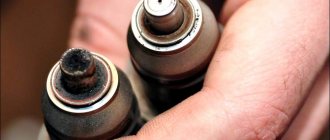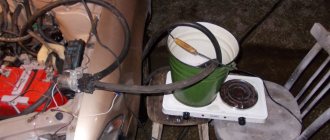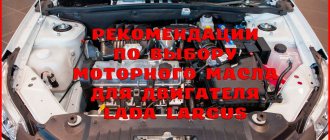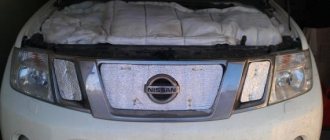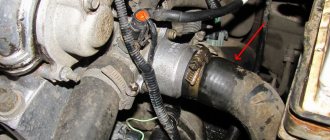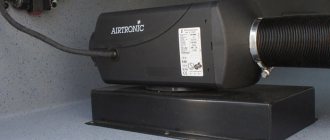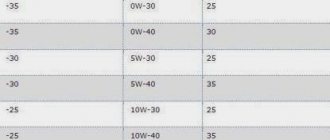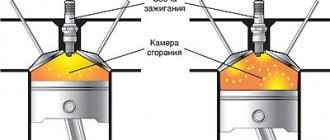How often to wash
Before we move on to a direct description of certain products, I would like to remind you how important it is to regularly flush the car’s cooling system. The fact is that, depending on the coolant used, rust, oil deposits, antifreeze decomposition products, and scale accumulate on the walls of the tubes that make up the radiator. All this leads to difficulty in coolant circulation and reduced heat transfer. And this always has a bad effect on the performance of the engine and increases the wear of its individual parts with the risk of their premature failure.
It is worth noting that flushing the system can be both internal and external (external cleaning involves flushing the radiator from the outside to remove particles of dirt, dust, and insects on its surface). It is recommended to do the internal flushing of the cooling system at least once a year . It is best to do this in the spring, when there is no longer frost, and a hot summer lies ahead.
On some cars, there is a light on the dashboard with a picture of a radiator, the glow of which may indicate not only a decrease in the antifreeze level, but also that it is time to change it. This may also serve as a signal that it is time to clean the cooling system. There are also a number of indirect signs of the need for such cleaning:
Radiator icon indicating problems with the cooling system
- frequent engine overheating;
- problems with the pump;
- slower response to rheostat signals (inertia);
- high temperature readings from the corresponding sensor;
- problems in the operation of the “stove”;
- The fan always runs at high speed.
If the engine gets very hot, then it’s time to select a product to flush the cooling system, and choose the time and opportunity for this.
When to flush
During operation, the radiator of the cooling system may become clogged. Moreover, it comes from the outside and from the inside. Today, manufacturers are trying to use higher quality materials, but even they do not protect against corrosion and scale.
If the antifreeze used is not replaced in time, it can also negatively affect the condition of the unit. A complex of such phenomena leads to the cooling system becoming dirty and in need of urgent cleaning.
It is not difficult to determine contamination of CO (cooling system) by a constantly overheating engine, regardless of weather conditions.
The frequency of flushing directly depends on operating conditions, engine condition, CO components used, etc.
Folk remedies for flushing the cooling system
As we indicated above, there are two types of cleaning products - traditional and special. Let's start with the first ones, as they are cheaper and more proven.
Lemon acid
Using citric acid to clean the cooling system
The most common citric acid, diluted in water, can clean radiator tubes from rust and dirt. It is especially effective if ordinary water is used as a coolant, since acidic compounds are effective against rust, and alkaline ones are effective against scale . However, remember that a citric acid solution is not able to remove significant stains.
The composition of the solution is as follows - dissolve 20-40 grams of the substance in 1 liter of water, and if the contamination is strong, then the amount of acid per liter can be increased to 80-100 grams (a larger volume is created in a similar proportion). The ideal option is when adding acid to distilled water, the pH level is around 3 .
The cleaning procedure itself is simple. It is necessary to drain all the old fluid and fill in a new solution. Next, you need to warm up the engine to operating temperature and leave it for several hours (or better yet, overnight ). Next, drain the solution from the system and look at its condition. If it is very dirty, then the procedure must be repeated 1-2 more times until the liquid is clean enough. After this, be sure to flush the system with water. Next, fill in the product that you plan to use as a coolant.
Acetic acid
Using acetic acid to clean the cooling system
The action of this solution is similar to that described above. An acetic acid solution is excellent for flushing the cooling system from rust. The proportions of the solution are as follows - half a liter of vinegar per bucket of water (10 liters). The cleaning procedure is similar - drain the old fluid, fill in new fluid and warm up the car to operating temperatures. Next, you need to leave the car with the engine running for 30-40 minutes so that chemical cleaning occurs in the radiator. Next, you need to drain the cleaning liquid and look at its condition. Repeat the procedure until the liquid becomes clear. Next, you need to rinse the system with boiled or distilled water, and then fill in the coolant that you plan to use on an ongoing basis.
Fanta
Using Fanta to clean the cooling system
Similar to the previous point. However, there is an important difference. The fact is that, unlike Coca-Cola, which uses orthophosphoric acid, Fanta uses citric acid , which has a lesser cleansing effect. Therefore, some car owners use it instead of antifreeze to clean the cooling system.
As for the time during which you need to drive like this, it all depends on the degree of contamination of the system. In particular, if it is not very dirty, and cleaning is done more for prevention, then it is enough to let the engine run for 30-40 minutes at idle speed. If you want to thoroughly wash out the old dirt, then you can ride like this for 1-2 days, then pour distillate into the system, ride it some more, drain it and look at its condition. If the distillate is dirty, repeat the procedure until the system is clean. At the end, do not forget to rinse it thoroughly with water and fill it with new antifreeze.
Lactic acid or whey
An excellent option for flushing a car engine cooling system is lactic acid . However, a significant problem lies in the fact that lactic acid is very difficult to obtain today. But if you manage to get this substance, then you can pour it into the radiator in its pure form and drive it for a while (or let the car sit with the engine running).
A more affordable alternative to lactic acid is whey. It has similar properties for cleaning the radiator and other elements of the cooling system. The algorithm for using the serum is as follows:
Using whey
- Prepare about 10 liters of whey in advance (preferably homemade, not from the store);
- strain the entire purchased volume 2-3 times through cheesecloth in order to filter out large pieces of fat;
- first drain the existing coolant from the radiator and pour in the serum in its place;
- drive 50-60 kilometers with it;
- It is necessary to drain the whey while it is hot, so that the dirt does not have time to stick to the walls of the tubes again ( be careful when doing this! );
- let the engine cool down;
- pour pre-boiled water into the radiator;
- start the engine, let it warm up (about 15-20 minutes); drain the water;
- let the engine cool down;
- fill in the antifreeze that you plan to use on an ongoing basis;
- Bleed air from the system and add more coolant if necessary.
What is not recommended for flushing the cooling system?
Among the so-called folk remedies, there are a number of those that are not recommended for use, despite the fact that some car owners still use them, and in some cases they even help. Let's give a few examples.
Coca-Cola
Using Coca-Cola as a Cleaner
Some motorists use Coca-Cola to flush the cooling system of oil, emulsion, scale and rust. The fact is that it contains orthophosphoric acid , with which you can easily get rid of the mentioned contaminants. However, in addition to acid, this liquid contains large amounts of sugar and carbon dioxide, which can lead to certain problems.
If you decide to use Cola as a cleaning liquid, it is better to first release carbon dioxide from it so that during the expansion process it does not harm individual engine components. As for sugar, after using the liquid, you must thoroughly rinse the cooling system with plain water.
Fairy
Some car enthusiasts use the popular household grease cleaner Fairy or its analogues to flush the cooling system of oil. However, its use is associated with a number of problems. Firstly, its composition is designed to combat dietary fat, and it simply cannot cope with motor oil. And even if you try to pour it into the radiator, you will have to fill and “boil” the engine several dozen times.
Calgon and its analogues
Calgon, Tiret and similar products are not recommended for cleaning radiators, since their intended purpose is to remove limescale deposits on water pipes.
"White"
The peculiarity of “Belizna” is that it contains sodium hypochlorite, which corrodes aluminum. And the higher the temperature of the liquid and the working surface, the faster corrosion occurs (according to the exponential law). Therefore, under no circumstances should you pour various stain removers into the system, especially those containing bleach and compounds based on it (including “Mr. Muscle”).
Known in narrow circles, “Mole” is made on the basis of caustic soda. Accordingly, they cannot be used to treat aluminum radiators and other surfaces. It is only suitable for cleaning copper radiators (in particular, stove radiators) and only by removing it and running such a cleaner through the system will you kill all the rubber seals and seals.
Other mixtures
Some car enthusiasts use a mixture of citric acid (25%), soda (50%) and vinegar (25%) for cleaning. However, we do not recommend that you do the same, since it is very rough and corrodes rubber and plastic parts.
Signs and causes
Replacing an air lock in the engine cooling system is quite easy. If the car begins to heat up quickly, and the heater begins to heat much worse, then this is the first bell. However, the cause of overheating is only an air lock, but also a malfunctioning thermostat. So, if the plug is removed, but the situation with the car has not changed, then you should check the functionality of the thermostat. Perhaps it needs to be changed.
Typically, in the cooling system of a VAZ 2110 injector, an air lock occurs when replacing cooled liquid, but this is not the only reason for its occurrence. This problem can occur in several other cases, which are described in more detail below.
Special liquids for flushing the radiator
The means listed above, of course, can be used to flush the radiator and cooling system of a car, but they have already become obsolete both morally and technologically. Currently, auto chemical manufacturers offer consumers a wide range of different cleaning products that cost quite reasonable money, that is, affordable to the average car owner.
Types of liquids
There are several types of cleaning fluids for radiators, which are divided by chemical composition. In particular:
- Neutral . Such liquids do not contain aggressive substances (in particular, alkalis and acids). Therefore, they are not able to wash away significant contamination. As a rule, neutral compounds are used as prophylaxis.
- Acidic . As the name implies, their composition is based on various acids. Such liquids are excellent for purifying inorganic compounds.
- Alkaline . Here the basis is alkali. Excellent for removing organic contaminants.
- Two-component . They are produced on the basis of both alkalis and acids. Thus, they can be used as a universal cleaner to flush the cooling system of scale, rust, antifreeze breakdown products and other compounds.
Popular liquids
We present for you an overview of the most popular liquids in our country for flushing a car’s cooling system, as well as some reviews from car enthusiasts who have used this or that liquid. We hope that the information below will be useful to you, and you will know the best way to flush your cooling system.
Final operation
Flushing continues by preparing a special tool. It can be made from an M6 stud, which is rounded and polished on one edge. Since the internal dimension of the PTFE tube is larger than the equivalent diameter of the stud, heat shrink will be required to tightly fit the two mating elements.
Regardless of what kind of oil is in the Chevrolet Niva engine, follow the following sequence:
TOP 3 best liquids for flushing the cooling system
LAVR Radiator Flush
LAVR Radiator Flush Classic . LAVR is a Russian brand of auto chemical goods. LAVR Radiator Flush Classic is an excellent solution for flushing the cooling system of any car. Product catalog number is LN1103. The approximate cost of a 0.43 liter package is $3.5, and a 0.98 liter package is $5.10.
A 430 ml bottle will be enough for you to use in a cooling system with a total volume of 8.10 liters. The composition is poured into the system and topped up with warm water to the MIN mark. After this, the engine should run for about 30 minutes at idle speed. Next, the product is removed from the system and washed with distilled water for 10.15 minutes with the engine running at idle. After this, you can fill in new antifreeze.
The useful properties of the product include an increase in the service life of antifreeze by 30.40%, effective removal of scale, antifreeze decomposition products, rust, and dirt. Contains a corrosion inhibitor, increases the life of the pump and thermostat.
| Positive feedback | Negative reviews |
| I simply used the Laurel wash because literally shortly before I had just used a ring decarbonizer under the same name, I saw the result, so I decided not to tempt fate and use a product from the same company. | No negative reviews found. |
| At one time I also used Laurel on a VAZ-21099. The impressions are only positive. But I also did washings every two years. So I never had dirt in the cooling system. | . |
Washing and decoking with Dimexide
This method is quite simple and not very expensive. To complete the procedure, perform the following steps:
- purchase inexpensive mineral oil, for example Volga OIL 15 (10 liters);
- buy a flushing agent such as “Lukoil” (4 l);
- take the original filter element for replacement;
- four pieces of DODA oil filters (better quality analogues);
- you will also need a fluoroplastic tube with a diameter of 8 millimeters and a length of about 0.4 m;
- M6 stud;
- thermal shrinkage.
To decarbonize with Dimexide you will need the solution itself (about 2.5 liters), as well as a syringe, an industrial hair dryer, a drill, gloves and rags. It is worth noting that this procedure requires compliance with certain safety measures associated with the use of PPE. The composition in question leaves burns on the skin, not to mention the mucous membranes. In addition, it has a negative effect when it comes into contact with most types of plastic. On average, with a careful and leisurely independent approach, the entire operation will take from 6 to 8 hours.
Why and how often is the VAZ 2110 cooling system flushed?
The VAZ-2110, like most domestic cars, is very susceptible to the harmful effects of scale accumulated in the channels and pipes of the radiator. These deposits make it difficult for coolant to circulate through the system, causing the engine to overheat. You can prevent unpleasant consequences only by flushing the pipes.
You've probably noticed how antifreeze darkens when it's time to change it. This is because the car radiator gets dirty. A side effect of this phenomenon is an increase in fuel consumption. The “stove” also stops working normally, since it is directly connected to the cooling system.
You say: “Why is this so, because antifreeze is not water, where does the scale come from?” Of course, non-freezing liquid does not cause scale, but if you do not change it in a timely manner, but only top it up, then over time the additives that are part of the antifreeze will begin to disintegrate, depositing a thick layer of plaque on the walls.
Do-it-yourself or professional washing
Today, flushing the VAZ 2110 engine cooling system can be done in two ways.
- On one's own. This saves money significantly, but takes time, effort and nerves.
- With the help of auto repair shops. You don’t have to waste precious time, but the service costs money.
Each option has its own strengths and weaknesses. If you still prefer to wash it yourself, it is not enough for you to have a garage and tools at your disposal. First, study the nuances of the operation, read the instruction manual for your car, study the coolants used, etc.
Traditional methods of flushing the engine cooling system
Let’s immediately make a reservation that the radiator and engine are washed with different liquids. It is not advisable to use acid solutions to flush the engine, since many parts in it are made of aluminum alloy, which cannot withstand the effects of such liquids. Moreover, the system is harmed by two things: metal corrosion products and antifreeze decomposition products, and these pollutants are cleaned out with different solutions. Therefore, no special auto chemicals will immediately clean the car of all contaminants. We offer you the following cleaning methods.
Lemon acid
You will need no more than 300 g of citric acid per 10 liters of water. It is better not to overestimate the acid concentration for the reasons described above. If the car is not older than three years, no flushing is needed, just change the antifreeze.
What do we have to do:
- First we drain the old “anti-freeze”.
- Instead of used antifreeze, fill in a solution prepared with clean water.
- We start the engine, warm it up to operating temperature (not higher than 90 degrees, otherwise the acid will react with everything it comes into contact with).
- You can drive in this mode for a couple of kilometers.
- After 40 minutes of operation, the solution is drained. The motor is washed with clean water.
Coca-Cola is coming to us!
Do you think the cooling system cannot be flushed with carbonated water? It turns out that it is possible, and how! Coca-Cola is perfect for this purpose, especially on domestic cars. Surprisingly, even experienced car enthusiasts do this and it does not lead to any bad consequences.
Troubleshooting
This process begins with the preparation of tools. The following devices will be required:
Do-it-yourself engine overhaul in the future will require thorough washing of the parts in kerosene. Then they must be blown and dried with a compressed air stream. A careful visual inspection of the crankshaft bearings and other components is carried out to ensure there are no cracks or chips. Similar defects are also not allowed in cylinders.
You may be interested in:Super SUV: characteristics and price
According to the manufacturer's documentation, a mark with the conventional index of the cylinder block is applied to the bottom of the block. A similar number must be present on all main bearing compartments, which determines their belonging to a specific cylinder head assembly.
How to properly rinse with special products
Good auto chemicals do not harm the engine and effectively remove contaminants. They come in three types: acidic, alkaline and two-component. To flush the system with a special solution, it is desirable to have distilled water. It is to this that a specialized additive from Hi-Gear or another manufacturer is added. After this, the engine is left to idle for about 10 minutes and the spent solution is drained.
What to do:
- Remove the expansion tank plug.
The plug is removed from the expansion tank
There is a hole in the cylinder block for draining antifreeze
Preparation
You may be interested in:Tuning Jeep Wrangler: possible changes and description of the process
In order to repair the Chevrolet Niva engine, you will need to stock up on the necessary set of tools. This kit includes:
- a set of keys from “10” to “36” or a universal analogue, you can also use a gas model;
- socket heads at “12” and “13”;
- hammer;
- screwdriver;
- special puller for the oil filter.
If possible, it is better to work on a rotating stand, which allows you to approach the motor from different sides. This feature is due to the fact that the power unit is quite problematic to securely fix. Otherwise, it is difficult to unscrew fasteners that are tightened with great force.
Air lock: what is it and how to remove it
An air lock may appear in the cooling system - usually this is the result of incorrect actions to replace antifreeze. To remove this interference you will need a screwdriver.
An air lock can quickly cause the engine to overheat. It can occur not only when replacing the coolant, but also when the system is depressurized (the hose is poorly fitted, the clamp is not secured).
This trouble is eliminated as follows:
- Remove the expansion tank plug.
- Locate the antifreeze inlet and outlet hoses.
- Apply several sharp pressures to the hoses. The air should come out.
- Close the expansion tank and start the engine.
Do-it-yourself or professional washing
Today, flushing the VAZ 2110 engine cooling system can be done in two ways.
- On one's own. This saves money significantly, but takes time, effort and nerves.
- With the help of auto repair shops. You don’t have to waste precious time, but the service costs money.
Each option has its own strengths and weaknesses. If you still prefer to wash it yourself, it is not enough for you to have a garage and tools at your disposal. First, study the nuances of the operation, read the instruction manual for your car, study the coolants used, etc.
